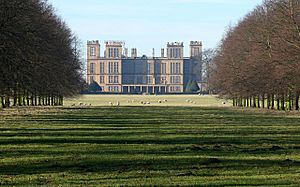Lord James Cavendish (MP for Derby) facts for kids

Lord James Cavendish was an important British politician who lived in the 1700s. He was a member of the Cavendish family, a very well-known and powerful family in Britain. He served as a Member of Parliament (MP) for many years, representing the town of Derby. Being an MP meant he helped make laws and decisions for the country. He was also a Fellow of the Royal Society, which means he was recognized for his contributions to science and knowledge.
Early Life and Family

Lord James Cavendish was born into a very important family. His father was William Cavendish, 1st Duke of Devonshire, who owned the grand Chatsworth House in Derbyshire. His mother was Lady Mary Butler.
James was the third son, so he didn't inherit the family's main titles or estates. When his father passed away, his older brother became the 2nd Duke of Devonshire. His brother was married to Rachel Russell, who was a close helper to Queen Anne.
Before starting his political career, James traveled a lot. He visited France and Italy between 1696 and 1698. He even studied at Padua University in Italy in 1697, which was a famous place for learning.
Political Career

Lord James Cavendish began his political journey by becoming a Member of Parliament (MP) for the town of Derby. He was first elected in 1701. He was a member of the Whig party, which was one of the main political groups at the time.
He was elected again in 1705. During this time, he often supported the government's plans. For example, he voted for a bill that made it easier for people from other countries to become British citizens. He also voted on important issues like the impeachment of Dr. Sacheverell, which was a big debate about religion and politics.
After a short break, he was re-elected for Derby in 1708. He continued to vote on important laws. However, he lost his seat in the 1710 election and didn't run in 1713.
Lord James returned to Parliament in 1715. He voted for the Septennial Act, which changed how often elections were held. He also supported repealing (getting rid of) some laws that limited religious freedom for certain groups.
He was re-elected without opposition in 1722 and 1727. In these later years, he sometimes voted with the government and sometimes against it. This showed that he was an independent thinker. For example, he voted against some government proposals about the army and taxes, but supported others.
He was elected one last time in 1741. However, in 1742, he left his seat in Parliament to take on a new job in Ireland. He became the Auditor of Foreign Accounts, which meant he was in charge of checking financial records related to foreign trade. After this, he did not run for Parliament again.
Family and Legacy

Lord James Cavendish married Anne Yale in 1708. Anne was the daughter of Governor Elihu Yale, who is famous for helping to found Yale University in America.
Lord James and Anne had two children:
- William Cavendish: Their son, William, sadly passed away in July 1751, just a few months before his father. He had married Barbara Chandler, whose father was a bishop. William and Barbara did not have any children.
- Elizabeth Cavendish: Their daughter, Elizabeth, married Richard Chandler in 1722.
Since his only son died before him, Lord James's main heir was his son-in-law, Richard Chandler. To continue the family name, Richard Chandler later adopted the name Cavendish.

